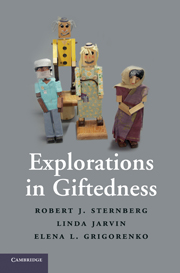Book contents
- Frontmatter
- Contents
- Preface
- 1 What Is Giftedness?
- 2 Theories of Giftedness
- 3 WICS as a Model of Giftedness
- 4 Intelligence and Giftedness
- 5 Creativity and Giftedness
- 6 Wisdom and Giftedness
- 7 Giftedness as Developing Expertise
- 8 Giftedness and Culture
- 9 Learning Disabilities, Giftedness, and Gifted/LD
- 10 Identifying the Gifted
- 11 Educating the Gifted
- References
- Index
5 - Creativity and Giftedness
Published online by Cambridge University Press: 05 June 2012
- Frontmatter
- Contents
- Preface
- 1 What Is Giftedness?
- 2 Theories of Giftedness
- 3 WICS as a Model of Giftedness
- 4 Intelligence and Giftedness
- 5 Creativity and Giftedness
- 6 Wisdom and Giftedness
- 7 Giftedness as Developing Expertise
- 8 Giftedness and Culture
- 9 Learning Disabilities, Giftedness, and Gifted/LD
- 10 Identifying the Gifted
- 11 Educating the Gifted
- References
- Index
Summary
As mentioned in Chapter 3, creativity is the ability to produce work that is novel (i.e., original, unexpected), high in quality, and appropriate (i.e., useful, meets task constraints) (Cropley & Cropley, in press; Lubart, 1994; Ochse, 1990; Sternberg, 1988b, 1999b; Sternberg & Lubart, 1995, 1996). Creativity is a topic of wide scope that is important at both the individual and societal levels for a wide range of task domains. At an individual level, creativity is relevant – for example, when one is solving problems in school (Beghetto, in press; Smith & Smith, in press), on the job (Puccio & Cabra, in press), and in daily life (Richards, in press). At a societal level, creativity can lead to new scientific findings, new movements in art, new inventions, and new social programs. The economic importance of creativity is clear because new products or services create jobs. Furthermore, individuals, organizations, and societies must adapt existing resources to changing task demands to remain competitive. The most important contributions to a society are generally made by those who are most creative (Simonton, in press). This chapter attempts to provide readers with a basic understanding of the literature on creativity. It first reviews alternative approaches to understanding creativity. Then it reviews alternative approaches to understanding kinds of creative work. Finally, it draws some conclusions. For a more thorough review of theories and perspectives on creativity, see Kaufman and Sternberg (in press) and especially Kozbelt, Beghetto, and Runco (in press).
- Type
- Chapter
- Information
- Explorations in Giftedness , pp. 82 - 101Publisher: Cambridge University PressPrint publication year: 2010

